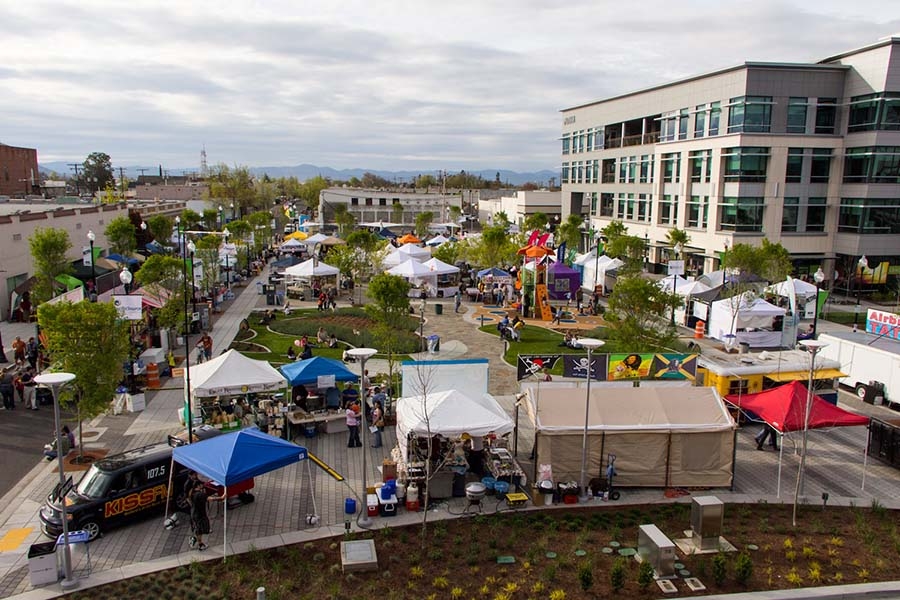A dearth of city leadership and the demise of a downtown association stymie Medford revitalization efforts.
Downtown Medford was on the cusp of change. The city of 77,677 people boasts a great climate, a core population of retirees and a strong health care sector. And thanks to leadership and investment from Mark DeBoer, a vice president at Lithia Motors, and Ashland developer Doug Neuman, the southern Oregon city was on a path to accomplish more: revitalize its downtown and market itself to tourists, as well as businesses.
It’s been nearly two years since we asked: Will Medford Ever Be Cool? That article documented efforts by DeBoer and Neuman to funnel money into the city redevelopment projects including a new Lithia headquarters and renovations to the Inn at the Commons (formerly the Red Lion Hotel).
The city also played a role, approving $14.1 million in urban renewal financing for the two projects. The long-term plan was to use these projects to attract businesses and boost tourism with a stronger city identity and urban amenities.
Those well-intentioned plans have stalled. Metro Medford Downtown Association, the marketing group that was working to create a brand for Medford, has disbanded. The homeless population is still a problem. The economy is still recovering from the 2008 crash.
It’s not all doom and gloom. Consumer reviews suggest the project by the Neuman Group is paying off. The city recently renovated Hawthorne Park downtown, and staff say the greenspace is a draw for families.
But as DeBoer points out, the project also displaced many homeless residents, who then migrated downtown.
A Medford native, DeBoer says “the city needs to get on board with figuring out a better solution.”
DeBoer says Medford doesn’t want to become another Ashland or Bend, but needs to develop its own brand.
“A city can copy or have inspiration from other cities, but every cool city I have been to takes on its own identity organically during a major push to redevelop,” DeBoer says. “Medford just needs more push to finds its own identity.”
The hotel and dealership headquarters are just two pieces of the puzzle.
“Lithia and the Neumans are doing what we can but need others to rally around,” he says. Change needs to be driven by city officials, who have yet to put their weight behind Medford’s renovation effort, DeBoer says.
“Until the city has had enough of the negative opinion and attitudes of its downtown, not a lot is going to drastically change.”
RELATED STORY: Will Medford Ever Be Cool?
The city declined to make the mayor or council leaders available for an interview. In an unusual turn of events, Mayor Gary Wheeler discussed OB’s questions during a recent council officers meeting, and the council collectively drafted a response to our inquiries.
In the draft response, the mayor and council cited Lithia’s headquarters and the redeveloped Hawthorne Park as positive examples of redevelopment.
“Revitalization and goals for new development will be one of the topics for discussion by the new City Council,” the draft response said.
Three new city council members will join a new city manager, Brian Sjothun, in January. “There are items for consideration in creating a vision for not only the downtown, but Medford as a whole,” the draft response said.
New momentum may also come from a city-organized “Downtown Solutions Committee,” tasked with addressing challenges to development.
Brad Hicks, CEO of the Medford Chamber of Commerce, says Medford doesn’t have new problems, just ongoing issues to address: lack of affordable housing and homelessness, aging infrastructure, dwindling land supply, workforce development challenges. And a lack of trust in government.
“On the flip side of the coin, one the great advantages we have in southern Oregon is that the old way of job seeking and transplanting companies has been changing around us for some time,” Hicks says. “It used to be that people went where the jobs were located without much thought as to the place itself. Today, jobs are inclined to go to places people want to live, and people want to live in southern Oregon.”




